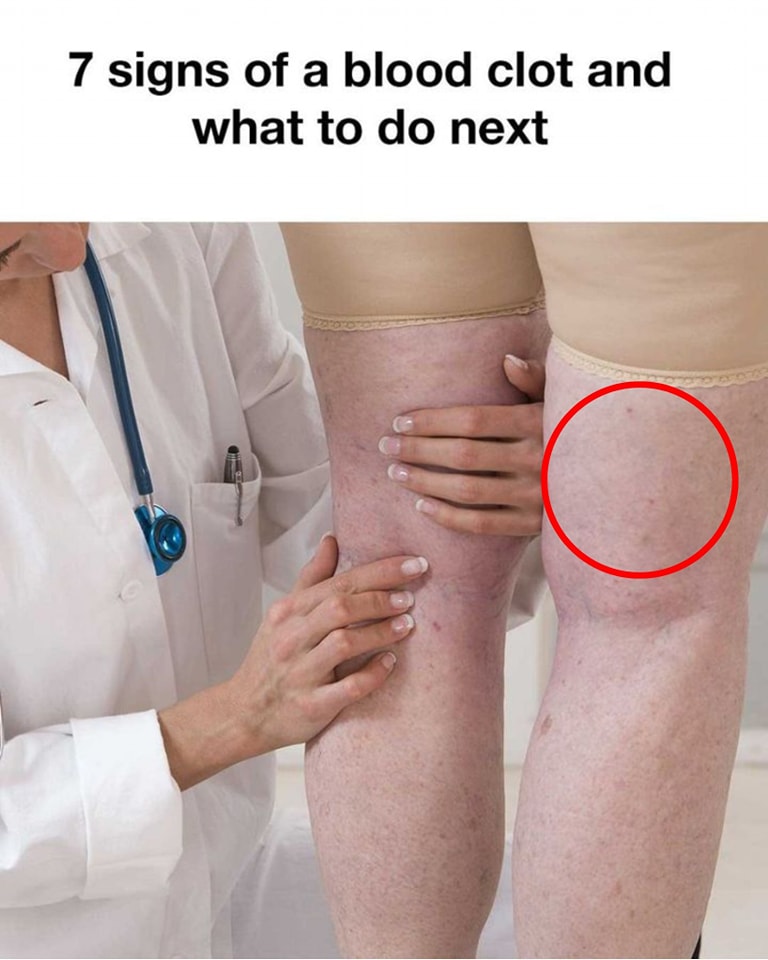7 Signs of a Blood Clot (Thrombosis) and What to Do Next
A blood clot (also known as a thrombus) can be dangerous, especially if it forms in the deep veins (deep vein thrombosis – DVT) or travels to critical organs like the lungs (pulmonary embolism – PE), heart, or brain.

Here are 7 key warning signs to watch for:
1. Swelling in One Limb (Usually the Leg)
- What it looks like: Sudden, unexplained swelling in one leg, foot, or arm.
- Why it matters: A clot may be blocking the normal flow of blood, causing fluid buildup.
- What to do: Don’t massage the area. See a doctor immediately to prevent the clot from moving.
2. Pain or Tenderness in the Leg or Arm
- What it feels like: Cramping, soreness, or an ache that feels like a pulled muscle, usually in the calf or thigh.
- Why it matters: Pain in a specific spot without injury could mean a clot is present.
- What to do: Don’t ignore persistent or worsening pain—seek medical evaluation.
3. Red or Discolored Skin
- What it looks like: Red, bluish, or darkened skin in the affected area.
- Why it matters: A clot can disrupt circulation, leading to discoloration.
- What to do: Note any color changes, especially if combined with swelling or pain.
4. Warmth Over the Affected Area
- What it feels like: The skin over the clot may feel warmer than surrounding areas.
- Why it matters: Inflammation caused by the clot raises the skin temperature.
- What to do: This is a key symptom of DVT and needs urgent care.
5. Sudden Shortness of Breath
- What it feels like: Trouble breathing without physical exertion, or a feeling of being unable to take a full breath.
- Why it matters: This can indicate a pulmonary embolism—a clot that has traveled to the lungs.
- What to do: Seek emergency medical help immediately.
6. Chest Pain or Discomfort
- What it feels like: Sharp, stabbing pain that may worsen when breathing deeply or coughing.
- Why it matters: This could signal a clot in the lungs (pulmonary embolism) or even a heart-related issue.
- What to do: Call emergency services (like 911 in the U.S.) without delay.
7. Coughing Up Blood
- What it looks like: Pink, red, or rust-colored sputum while coughing.
- Why it matters: This is a serious symptom of a pulmonary embolism.
- What to do: Treat it as an emergency—go to the ER immediately.
What to Do If You Suspect a Blood Clot
✅ DO:
- Seek immediate medical attention—early diagnosis can prevent complications.
- Stay calm and limit movement, especially of the affected area.
- Inform the doctor of any risk factors (recent surgery, long travel, birth control pills, family history, etc.).
❌ DON’T:
- Don’t massage the swollen or painful area—it can dislodge the clot.
- Don’t wait for symptoms to “go away on their own.”
- Don’t take aspirin or blood thinners unless advised by a doctor.
Prevention Tips
- Stay hydrated.
- Move regularly during long flights or car rides.
- Avoid sitting or standing for long periods without moving.
- Wear compression stockings if advised.
- Maintain a healthy weight and avoid smoking.